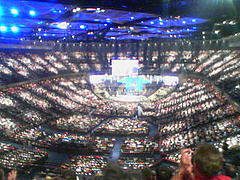Great news! Yesterday a new edition of the
Journal of the Book of Mormon and Other Restoration Scripture became available online at the Maxwell Institute. You can
download the entire journal as a PDF file, or any of the individual articles can be downloaded as PDF files. They are also available as text only. Here are the articles with links to the HTML pages, each of which then has a link to PDF version of the article.
- Sealings and Mercies: Moroni’s Final Exhortations in Moroni 10
by: James E. Faulconer, 4–19
- The Religious and Cultural Background of Joseph Smith Papyrus I
by: Kerry Muhlestein, 20–33
- Abraham and Idrimi
by: John Gee, 34–39
- The Zoramites and Costly Apparel: Symbolism and Irony
by: Parrish Brady, and Shon Hopkin, 40–53
- How Much Weight Can a Single Source Bear? The Case of Samuel D. Tyler’s Journal Entry
by: Matthew Roper, 54–57
- Kirtland Camp, 1838: Bringing the Poor to Missouri
by: Alexander L. Baugh, 58–61
- Worthy of Another Look: Reusages of the Words of Christ
by: John W. Welch, 62–72
I wish to particularly call attention to John Gee’s article, “Abraham and Idrimi,” which examines interesting parallels between the text of the Book of Abraham from the only other known autobiography from the specific region and time of Abraham. Here is the final paragraph of Gee’s article with some important food for thought:
According to Edward Greenstein and David Marcus, “The story of Idrimi is unlike Mesopotamian literature both in content and style.”31 The story, as Oppenheim describes it, is “without parallel in texts of this type from Mesopotamia and Egypt.”32 This led him to conclude that “all this seems to me to bespeak the existence of a specific literary tradition, totally different in temper and scope from that of the ancient Near East.”33 Thus Oppenheim considered the autobiography of Idrimi to be unusual even for the ancient Near East. But the Book of Abraham belongs to the same specific literary tradition as Idrimi’s autobiography. More inscriptions like Idrimi’s from Syria dating to the Middle Bronze Age would enable a better comparison, but it is at least worth asking, How did Joseph Smith manage to publish in the Book of Abraham a story that closely matched a Middle-Bronze-Age Syrian autobiography that would not be discovered for nearly a hundred years?
While some folks continue to make the tragic mistake of loosing faith over attacks based on the Book of Abraham, the evidence continues to mount for the authenticity of the Book of Abraham as an ancient text beyond anything Joseph could have fabricated. The evidence from the text of Idrimi is a minor part of that, but a fascinating one. One of the best treatments of other evidences for the Book of Abraham is the DVD, “A Most Remarkable Book: Evidence for the Divine Authenticity of the Book of Abraham.” Also see Evidence for the Book of Abraham from Ancient Texts. Yes, there are still many questions and some things on the facsimiles that just seem wrong, like identifying a servant on Facs. 3 as Shulem when that is clearly not what the characters on that figure say. But there are so many strange and surprising elements that make sense or even appear to be “bulls eyes” that we cannot blindly disregard.










Although I find the Book of Abraham fascinating as well, I'm too lazy to read John Gee's article, but if John Gee is saying that Idrimi's autobiography has no parallels in Mesopotamia or Egypt, and the Book of Abraham belongs to the same class as Idrimi, doesn't that imply that the Book of Abraham has no parallels in Mesopotamia or Egypt? That seems like evidence against its historical authenticity rather than for it.
Steven:
The autobiography of Idrimi is from Middle-Bronze Age Syria (MBAS). The Book of Abraham (BoA) takes place in "Ur of Chaldees" which exact location is unknown, but there are two possibilities, one of which is in Syria. If the Syrian location of Ur is granted (and I personally find those arguments compelling) then the BoA, if authentic, would also be a Middle-Bronze Age text from Syria. Thus, the fact that it compares favorably with Idrimi's autobiography (AboI) from that same time and place is evidence that it also comes from that same time and place. Especially since the AboI is so distinctive among ancient Near Eastern literature. This makes the comparison all the more compelling, as it suggests that texts from MBAS can be distinguished from other texts in the general region (from that time but in a different place) or texts from the same area but a different time.
So, in one sense, you are correct. It would suggest that the BoA didn't come from Mesopotamia or Egypt. But this doesn't undermine the authenticity, because the comparison suggests the text comes from MBAS–right where it is supposed to come from.
Nicely said, Neal. Thanks!
The facsimiles, created long after Abraham but being adapted to or relevant to the text, naturally show strong Egyptian influence since they are Egyptian, and some influence of Egypt and Mesopotamia on Abraham and his text, either the original or the redacted text, should not surprise us, but I think it makes sense to consider the original document as possibly MBAS.
What is the evidence that the Book of Abraham was redacted?